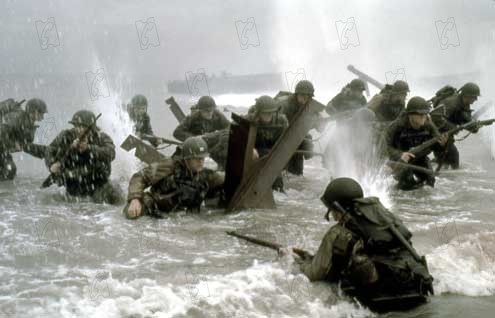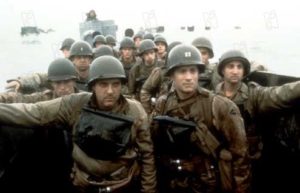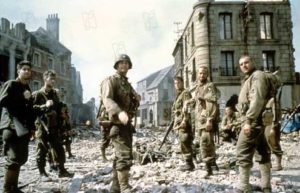Coluna Claquete – June 2nd, 2016 – Movie of the week
Newton Ramalho
colunaclaquete@gmail.com – www.colunaclaquete.blogspot.com– @colunaclaquete
Movie of the Week: “Saving Private Ryan”
Disembark in the real world
Yesterday, June 6th, 2016, completed 72 years of a special day in a terrible time, when the whole world was suffering under Second World War.Hitler and his armies dominated continental Europe, submited England with incessant bombing, but suffered defeats in cold Russia.On that day, the famous D-Day, Americans led the Allied invasion at a time when they were the good guys, who fought against the terrible Nazi.A lot of films have been made about this historic day, but only one was able to use all the magic of modern special effects, as well as an exquisite historical reconstruction work.The film was “Saving Private Ryan” directed by no one than Steven Spielberg.
What was this “D-Day”?
The film talks about the famous D-Day and the Normandy landings during the Second World War. Talking to some younger people, I have arrived an odd discovery: only few people know what represented D-Day or even what diferentiated Second World War from Vietnam War, Gulf War, or any other war we see every day on TV.I will add one more ingredient to that: any of us has any idea of what is a real war? I do not think so.
The Second World War was the result of a unique situation in the world, where a vast majority of countries – ours included – was dominated by fascist dictators or colonialistic empires.For those who had survived a hellish early thirties, when the world economy was shaken by Great Depression of 1929, it was reassuring to have a stable situation, even if individual rights were restricted.It was so in Germany with Hitler, Mussolini in Italy, in Spain with Franco, Salazar in Portugal, Argentina with Perón, in Brazil with Vargas and so on.
Germany was the greatest exponent of that era. Subjected to heavy repairs of First World War, they went through a dark period that ended showing be the ideal birthplace for the rise of Nazism. A picture of this period is magnificently exposed in the movie “The Sepent’s Egg” by Ingmar Bergman.
Methodically, Hitler structured the country to be a military power. Taking advantage of the inertia of those who could do opposition, Britain and France, he annexed neighboring countries until the situation reached the point where there were no return. In 1939, the real war has started. For two years, most of the activities are concentrated in Europe, with almost total domination of Germany. Only England resisted the German invasion, despite being subjected to endless bombardments. With Japan’s attack on Pearl Harbor in 1941, the United States officially entered the war, also participating in operations in Europe.
In 1944, despite the capitulation of Italy, France and neighboring countries were still occupied by the Germans.A large landing was planned and was expected by all, even if the exact day and place was the greatest secret of the war. The importance of this was the position of the German defenses, commanded by General Rommel, who had made a brilliant campaign in North Africa, where he earned the nickname “Desert Fox”.Counting with fewer resources, he had to shift some troops from one point to another due to the attack.
On June 6, 1944, the landing was made in Normandy. If we suppose that the invasion was in Natal,the landing craft would bring the soldiers to Praia dos Artistas beach, where there would have a multitude of obstacles, barbed wire, mines, etc.. Thirty meters above, at Av. Getulio Vargas, there would be the German concrete casemates with cannons, mortars, large caliber machine guns, flamethrowers, etc..The soldiers, after landing, should face the heavy enemy fire for more than one hundred meters before they could fire a shot that made any effect.
In the first landing, the Allied forces had 2400 casualties, against 1200 of Germans. However, as replacement of Allied force was higher, the invasion was successful. At the end of the day June 6, 34 thousand soldiers had already landed.
Despite being decisive, the landing of Normandy did not mean the end of the war. Several more months would pass with bloody fighting and heavy casualties for both sides. Germany surrendered on May 7, 1945, while Japan would resist until September 2nd, 1945, being bent by the overwhelming force of two atomic bombs.
The war caused the direct death of fifty million people and virtually razed most of the places where the fighting took place.
The film
In “Saving Private Ryan” it is possible to have an idea of what was the landing of Normandy and the days that followed it.Unlike many other films about the Second World War, which gave a very neat vision, “Ryan” shows that a war is a slow, messy and painful process.
There were made more than five hundred films about the Second World War, including “The Longest Day”, which deals with the landing of Normandy.Unfortunately, like so many others, it shows an asseptic war, where heroes roam and kill hundreds of enemies. The deaths are romantic and fast, movements are organized, the situations are resolved quickly, prisoners of war are treated well … Pure bullshit, say combat veterans. The whole war situation is degrading, obscene, chaotic and wild. D-Day was all that and more.
As the character Tom Hanks says “I’m afraid to go home and my wife did not recognize me because of everything I’ve done in the war …”
To achieve the realism that distinguishes it from other films, Spielberg shows the action from the point of view of the soldiers. Those disembarking see their mates being slaughtered all the time.From German pillbox we see the devastation that the gun was, massacring the men who waded on the beach.
A great source of inspiration for the landing scenes were photos of Robert Capa, the most famous war correspondent, who actually participated in the action in Normandy, armed only with their cameras.
The film’s plot is based on a real fact, the story of the Niland brothers, from State of New York. The four brothers, aged between twenty and thirty and five years voluntarily enlisted and left to the war. Two of them died on D-Day, while another was presumed dead in Burma (Burma). Fritz Niland was located in Normandy by an army chaplain, Reverend Francis Sampson, and removed from the combat zone. After the war, the missing Niland was found, having survived in a Japanese prisoners camp.
In fiction, Captain John Miller (Tom Hanks) receives the mission to find and bring back the soldier Ryan, last survivor of four brothers who were in the war. By doing this, a group of eight men, faced German snipers, hanged a small battle in a radar station and finally found the wanted guy – just to discover that he refused to leave his post.
Determined to go back only with the boy, Captain Miller organized the resistance of a small village, whose bridge was strategic to the Germans.With poor human and material resources, Miller had to use all his combat experience to fulfill that almost suicidal mission.
The battle in the village is electrifying, although in a different way of the landing. Here we see the platitude of action movies, when the heroes go through rains of bullets and get out unscathed, as enemies fall like flies. Even so, there happens the common human reactions: heroism, selflessness, cowardice, self-immolation, etc..
Even after a decade and a half of his debut, “Saving Private Ryan” is a powerful and engaging film, showing an important historical fact with remarkable degree of fidelity.










